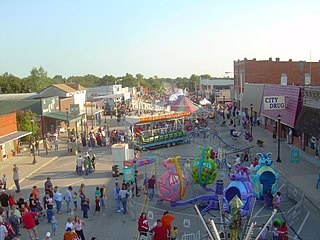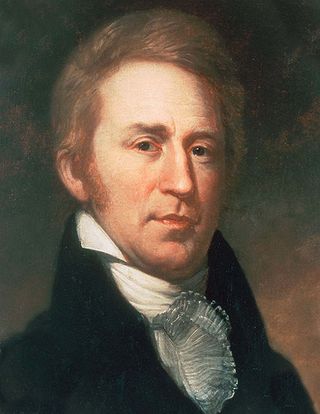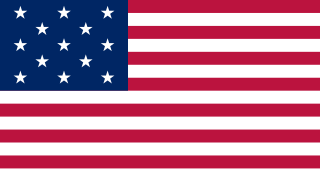
Indian Territory and the Indian Territories are terms that generally described an evolving land area set aside by the United States government for the relocation of Native Americans who held original Indian title to their land as an independent nation-state. The concept of an Indian territory was an outcome of the U.S. federal government's 18th- and 19th-century policy of Indian removal. After the American Civil War (1861–1865), the policy of the U.S. government was one of assimilation.

Coweta is a city in Wagoner County, Oklahoma, United States, a suburb of Tulsa. As of 2010, its population was 9,943. Part of the Creek Nation in Indian Territory before Oklahoma became a U.S. state, the town was first settled in 1840.

William Clark was an American explorer, soldier, Indian agent, and territorial governor. A native of Virginia, he grew up in pre-statehood Kentucky before later settling in what became the state of Missouri.

The Northwest Territory, also known as the Old Northwest and formally known as the Territory Northwest of the River Ohio, was formed from unorganized western territory of the United States after the American Revolution. Established in 1787 by the Congress of the Confederation through the Northwest Ordinance, it was the nation's first post-colonial organized incorporated territory.

The flags of the U.S. states, territories, and the District of Columbia exhibit a variety of regional influences and local histories, as well as different styles and design principles. Modern U.S. state flags date from the turn of the 20th century, when states considered distinctive symbols for the 1893 World's Columbian Exposition in Chicago, Illinois. Most U.S. state flags were designed and adopted between 1893 and World War I.

The Territory of Oklahoma was an organized incorporated territory of the United States that existed from May 2, 1890, until November 16, 1907, when it was joined with the Indian Territory under a new constitution and admitted to the Union as the state of Oklahoma.

The Indiana Territory, officially the Territory of Indiana, was created by an organic act that President John Adams signed into law on May 7, 1800, to form an organized incorporated territory of the United States that existed from July 4, 1800, to December 11, 1816, when the remaining southeastern portion of the territory was admitted to the Union as the state of Indiana. The territory originally contained approximately 259,824 square miles (672,940 km2) of land, but its size was decreased when it was subdivided to create the Michigan Territory (1805) and the Illinois Territory (1809). The Indiana Territory was the first new territory created from lands of the Northwest Territory, which had been organized under the terms of the Northwest Ordinance of 1787. The territorial capital was the settlement around the old French fort of Vincennes on the Wabash River, until transferred to Corydon near the Ohio River in 1813.

The Unassigned Lands in Oklahoma were in the center of the lands ceded to the United States by the Creek (Muskogee) and Seminole Indians following the Civil War and on which no other tribes had been settled. By 1883, it was bounded by the Cherokee Outlet on the north, several relocated Indian reservations on the east, the Chickasaw lands on the south, and the Cheyenne-Arapaho reserve on the west. The area amounted to 1,887,796.47 acres.

The State of Sequoyah was a proposed state to be established from the Indian Territory in eastern present-day Oklahoma. In 1905, with the end of tribal governments looming, Native Americans in Indian Territory proposed to create a state as a means to retain control of their lands. Their intention was to have a state under Native American constitution and governance. Their efforts failed to gain support in Congress, and the territory was annexed to the United States in 1907.

William McKendree Springer was an American attorney and politician who represented Illinois in the United States House of Representatives and served on the United States Court for the Indian Territory.

Bird Segle McGuire was an American politician, a Delegate and the last U.S. Representative from Oklahoma Territory. After statehood, he was elected as an Oklahoma member of Congress, where he served four consecutive terms. He retired from politics in 1915. He was a cousin of William Neville.

Hosea Townsend was an American attorney and politician who served two terms as a U.S. Representative from Colorado from 1889 to 1893.

John Robert Thomas, Sr., also known as J. R. Thomas, was a U.S. representative from Illinois. He was later appointed a U.S. district judge in the Indian Territory, which then encompassed most of the eastern part of present-day Oklahoma, serving from 1898 to 1901. After statehood, he served on the Oklahoma State Code Commission which was tasked with reviewing and editing the new state laws that had been hastily put together during the rush to statehood. After returning to his private law practice, he went to the Oklahoma state prison at McAlester to interview an inmate on January 19, 1914, when he was killed by three other inmates who shot him to death while escaping prison.
Louis Sulzbacher was the first continental American appointed as Associate Justice of the newly created Supreme Court of Puerto Rico in 1900. Appointed by President William McKinley he assumed his post in August 1900 and served until 1904.

The Sequoyah Constitutional Convention was an American Indian-led attempt to secure statehood for Indian Territory as an Indian-controlled jurisdiction, separate from the Oklahoma Territory. The proposed state was to be called the State of Sequoyah.

William A. Durant was a Choctaw politician in the U.S. state of Oklahoma. A lawyer, he sat in the tribal legislature and later became Speaker of the Choctaw Nation before its annexation in 1906. He played a role in Oklahoma statehood and served in the Oklahoma House, rising to become its third Speaker. He was the sponsor of a bill that created Southeastern Oklahoma State University. He served later in life as chief of the Choctaw Nation during World War II.
United States v. Ramsey, 271 U.S. 467 (1926), was a U.S. Supreme Court case in which the Court held that the government had the authority to prosecute crimes against Native Americans (Indians) on reservation land that was still designated Indian Country by federal law. The Osage Indian Tribe held mineral rights that were worth millions of dollars. A white rancher, William K. Hale, devised a plot to kill tribal members to allow his nephew, who was married to a tribal member, to inherit the mineral rights. The tribe requested the assistance of the federal government, which sent Bureau of Investigation agents to solve the murders. Hale and several others were arrested and tried for the murders, but they claimed that the federal government did not have jurisdiction. The district court quashed the indictments, but on appeal, the Supreme Court reversed, holding that the Osage lands were Indian Country and that the federal government therefore had jurisdiction. This put an end to the Osage Indian murders.
Joseph Thomas Dickerson was an American judge and politician who served on the United States Court for the Indian Territory between 1904 and 1907, in the Oklahoma House of Representatives between 1914 and 1916, and as an appointed judge in Oklahoma County.
The United States Court for the Indian Territory was a Federal Court of the United States in Indian Territory between 1889 and November 16, 1907, the day Oklahoma was admitted as a U.S. state.
Charles W. Raymond was an American judge who served on the United States Court for the Indian Territory between 1901 and Oklahoma statehood on November 16, 1907.